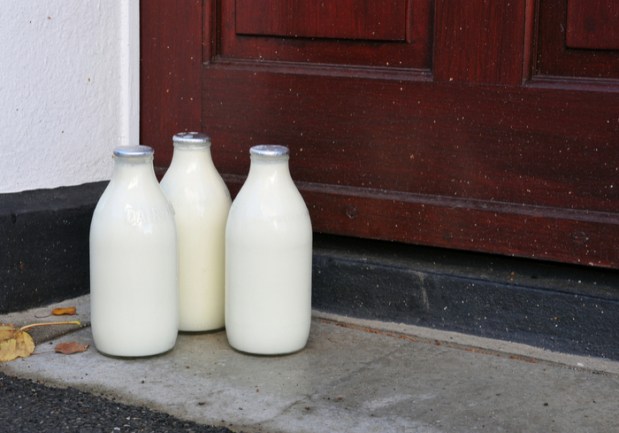Shipt, Deliv Couriers (Sort Of) Bring Back Days Of The American Milkman

In the 1700s, many families had their own cows. But as people traded their farm houses for city living — well, there wasn’t anywhere to keep farm animals.
So consumers began to purchase milk from dairy farmers, beginning in Vermont in 1785. A milkman would come to a consumer’s house with a barrel of milk, which he would fill with whatever containers the customer had on hand.
At the time, the milkmen served an important need: Many households didn’t have refrigeration. They relied on milkmen to deliver milk and the iceman to keep it cold so it wouldn’t spoil.
But, in the late 1800s, dairies began selling milk in glass bottles, which improved convenience and hygiene. In 1879, Echo Farms Dairy of Litchfield, Conn. pioneered this packaging by offering its delivery customers in New York City milk in glass bottles.
The Glass Bottle
Still, the glass bottles were not entirely liked by all. Some dairies worried that the glass would break. Consumers, too, were a bit wary of the packaging because they looked like drugstore containers.
Despite these misgivings, glass bottles became the norm for milk packaging. By the 20th century, cities were even mandating that milkmen deliver their product in glass bottles. But this method of packaging wasn’t without its downsides.
Bottles were lost at times. And, yes, it cost money to return the bottles to the bottling plant – and to wash and sterilize them. There was also the rather unpleasant fact that clean bottles with fresh milk were stored in the same vehicle as empty and unwashed bottles.
Even worse, some less-than-honest milkmen would fill empty and unwashed bottles with a fresh quart. But it wasn’t worries over hygiene that led to the milkman’s demise.
Eventually, it would be suburban sprawl that made milk delivery simply uneconomical. Following World War II, neighborhoods became larger and larger. As a result, routes became longer for the milkmen, and they had to spend more time driving between deliveries.
Finally, the advent of the supermarket led to the demise of the milkman as consumers drove to brick-and-mortar stores pick up containers of milk in their cars instead of having it delivered to their homes.
Grocery Delivery
Today, merchants are beginning to offer deliveries — not for health or safety, but to fend off competition from Amazon. It’s the opposite of the milkmen, however, who faced competition from stores that allowed consumers to pick up milk – and other grocery items.
Amazon got into the grocery business when it launched Amazon Fresh in 2007. As a result, retailers such as Walmart and Target are getting in on the delivery business by acquiring startups.
Target, of course, has bought Shipt in an effort to boost delivery of both grocery and non-grocery items, while Walmart has tapped Deliv. By partnering with the courier services, retailers like Target and Walmart can promise their customers same-day delivery and then process those deliveries through third parties.
Like the milkmen, Shipt and Deliv are economical, but for a different reason: They rely on part-time workers. Among others, the gig economy is powered by millennials still on their parents’ health insurance plans and baby boomers looking to stay busy in retirement, according to the PYMNTS Gig Economy Index.
The New Milkman
But there are still people that still want milk delivered the old-fashioned way. And, yes, there are still some companies that deliver milk. Manhattan Milk, for example, delivers milk produced by a dairy farm in Cortland, N.Y. that has been in business for generations. “It’s modernized nostalgia,” Frank Acosta, the company’s co-owner, told Eater.
The market for companies like Manhattan Milk is also customers that value convenience — like families with young children. But the milk doesn’t come cheap. Manhattan Milk requires its customers to order at least $15 of milk, and they must pay a $6 delivery charge. In comparison, a gallon of conventional milk in New York can be had for just over $2. Still, some customers are willing to pay for farm-fresh milk.
“There is a demand for it to be cheaper, more economical,” Acosta told Eater. “Some people want a Mercedes-Benz but want to pay for a Honda.” After all, having a milkman is not the most cost-effective distribution method. It’s cheaper for dairies to simply load up a tractor trailer and deliver it to a huge brick-and-mortar store to sell.
But for those who want a bit of nostalgia and perhaps the farm-fresh taste, there’s always delivery. And, maybe with August Home, the milkman will follow in the footsteps of other retailers — and deliver milk right to the fridge, too.
